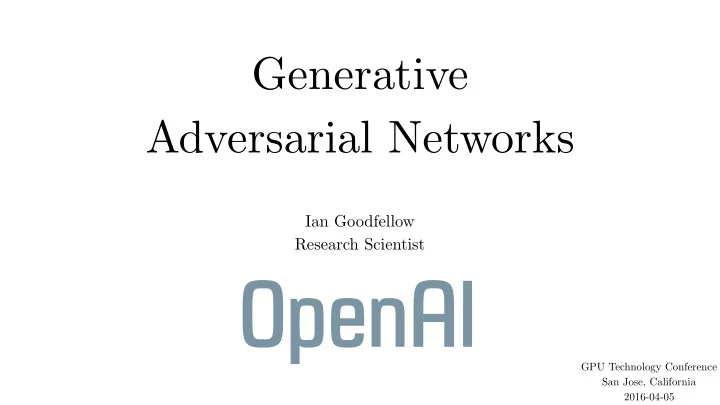

Generative Adversarial Networks Ian Goodfellow Research Scientist GPU Technology Conference San Jose, California 2016-04-05
Generative Modeling • Have training examples: x ∼ p train ( x ) • Want a model that can draw samples: x ∼ p model ( x ) • Want p model ( x ) = p data ( x ) (Images from Toronto Face Database)
Example Applications • Image manipulation • Text to speech • Machine translation
Modeling Priorities q ∗ = argmin q D KL ( p k q ) q ∗ = argmin q D KL ( q k p ) p ( x ) p( x ) Probability Density Probability Density q ∗ ( x ) q ∗ ( x ) ( Deep Learning , Goodfellow, Bengio, and Courville 2016) x x Put high probability where there Put low probability where there should be high probability should be low probability
Generative Adversarial Networks D tries to D tries to output 1 output 0 Differentiable Differentiable function D function D x sampled x sampled from data from model x x Differentiable function G (“Generative Input noise Adversarial Networks”, Z z Goodfellow et al 2014)
Discriminator Strategy Optimal D ( x ) for any p data ( x ) and p model ( x ) is always p data ( x ) D ( x ) = p data ( x ) + p model ( x ) Data distribution Model distribution
Learning Process Discriminator Data distribution response Model distribution ... After updating D After updating G Poorly fit model Mixed strategy equilibrium
Generator Transformation Videos MNIST digit dataset Toronto Face Dataset (TFD)
Non-Convergence (Alec Radford)
Laplacian Pyramid (Denton+Chintala et al 2015)
LAPGAN Results • 40% of samples mistaken by humans for real photographs (Denton+Chintala et al 2015)
DCGAN Results (Radford et al 2015)
Arithmetic on Face Semantics = - + Man wearing Man Woman glasses Woman wearing glasses (Radford et al 2015)
Mean Squared Error Ignores Small Details Input Reconstruction (Chelsea Finn)
GANs Learn a Cost Function Ground Truth MSE Adversarial Capture predictable details regardless of scale (Lotter et al, 2015)
Conclusion • Generative adversarial nets • Prioritize generating realistic samples over assigning high probability to all samples • Learn a cost function instead of using a fixed cost function • Learn that all predictable structures are important, even if they are small or faint
Recommend
More recommend